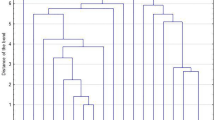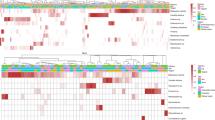Abstract
Systemic fungal infections are being recognized with increasing frequency in extremely premature neonates. We report two such infants with late-onset mixed infection with Staphylococcal species and unusual fungi. These cases are of interest in view of recent reports on the interaction of Staphylococcal cell wall components and neutrophils, as damaged skin sites could form a nidus and portal of entry for saprophytic fungal pathogens. It is also important to consider fungal infection as a possibility in sick premature infants with necrotic skin lesions even when the systemic signs have an alternative explanation with ongoing bacteremia.
This is a preview of subscription content, access via your institution
Access options
Subscribe to this journal
Receive 12 print issues and online access
$259.00 per year
only $21.58 per issue
Buy this article
- Purchase on Springer Link
- Instant access to full article PDF
Prices may be subject to local taxes which are calculated during checkout
Similar content being viewed by others
References
Kaufman D, Boyle R, Hazen KC, Patrie JT, Robinson M, Donowitz LG . Fluconazole prophylaxis against fungal colonization and infection in preterm infants. N Engl J Med 2001;345:1660–1666.
Salazar GE, Campbell JR . Trichosporonosis, an unusual fungal infection in neonates. Pediatr Infect Dis J 2002;21:161–165.
Panagopoulou P, Evdoridou J, Bibashi E, et al. Trichosporon asahii: an unusual cause of invasive infection in neonates. Pediatr Infect Dis J 2002;21:169–170.
Rowen JL, Atkins JT, Levy ML, Baer SC, Baker CJ . Invasive fungal dermatitis in the < or = 1000-gram neonate. Pediatrics 1995;95:682–687.
Yau YC, de Nanassy J, Summerbell RC, Matlow AG, Richardson SE . Fungal sternal wound infection due to Curvularia lunata in a neonate with congenital heart disease: case report and review. Clin Infect Dis 1994;19:735–740.
Sugita T, Nishikawa A, Ichikawa T, Ikeda R, Shinoda T . Isolation of Trichosporon asahii from environmental materials. Med Mycol 2000;38:27–30.
Fernandez M, Noyola DE, Rossmann SN, Edwards MS . Cutaneous phaeohyphomycosis caused by Curvularia lunata and a review of Curvularia infections in pediatrics. Pediatr Infect Dis J 1999;18:727–731.
Walsh TJ . Trichosporonosis. Infect Dis Clin North Am 1989;3:43–52.
del Palacio A, Perez-Revilla A, Albanil R, Sotelo T, Kalter DC . Disseminated neonatal trichosporosis associated with the hemophagocytic syndrome. Pediatr Infect Dis J 1990;9:520–522.
Henwick S, Henrickson K, Storgion SA, Leggiadro DJ . Disseminated neonatal Trichosporon beigelii. Pediatr Infect Dis J 1992;11:50–52.
Saiman L, Ludington E, Pfaller M, et al. Risk factors for candidemia in Neonatal Intensive Care Unit patients. The National Epidemiology of Mycosis Survey study group. Pediatr Infect Dis J 2000;19:319–324.
Brodie SB, Sands KE, Gray JE, et al. Occurrence of nosocomial bloodstream infections in six neonatal intensive care units. Pediatr Infect Dis J 2000;19:56–65.
Lopez Sastre JB, Coto Cotallo D, Fernandez Colomer B . Neonatal sepsis of nosocomial origin: an epidemiological study from the "Grupo de Hospitales Castrillo". J Perinat Med 2002;30:149–157.
Huang YC, Li CC, Lin TY, et al. Association of fungal colonization and invasive disease in very low birth weight infants. Pediatr Infect Dis J 1998;17:819–822.
Karlowicz MG, Hashimoto LN, Kelly RE, Jr . Buescher ES. Should central venous catheters be removed as soon as candidemia is detected in neonates? Pediatrics 2000;106:E63.
Stoll BJ, Hansen N, Fanaroff AA, et al. Late-onset sepsis in very low birth weight neonates: the experience of the NICHD Neonatal Research Network. Pediatrics 2002;110:285–291.
Kato T, Terui T, Zhen YX, Tagami H . Influence of staphylococcal lipoteichoic acid on the frustrated phagocytosis of neutrophils against opsonized corneocytes. Exp Dermatol 1993;2:171–174.
Kato T, Terui T, Hara M, Iizawa O, Tagami H . Enhancing effect of protein A on the interaction between opsonized corneocytes and neutrophils in staphylococcal infection. Exp Dermatol 1993;2:70–74.
Sharkey PK, Graybill JR, Rinaldi MG, Stevens DA, Tucker RM, Peterie JD, Hoeprich PD, Greer DL, Frenkel L, Counts GW, et al. Itraconazole treatment of phaeohyphomycosis. J Am Acad Dermatol 1990;23:577–586.
Espinel-Ingroff A . In vitro activity of the new triazole voriconazole (UK-109,496) against opportunistic filamentous and dimorphic fungi and common and emerging yeast pathogens. J Clin Microbiol 1998;36:198–202.
Kontoyiannis DP, Mantadakis E, Samonis G . Systemic mycoses in the immunocompromised host: an update in antifungal therapy. J Hosp Infect 2003;53:243–258.
Author information
Authors and Affiliations
Corresponding author
Rights and permissions
About this article
Cite this article
Maheshwari, A., Stromquist, C., Pereda, L. et al. Mixed Infection with Unusual fungi and Staphylococcal Species in Two Extremely Premature Neonates. J Perinatol 24, 324–326 (2004). https://doi.org/10.1038/sj.jp.7211077
Published:
Issue Date:
DOI: https://doi.org/10.1038/sj.jp.7211077
This article is cited by
-
A fatal outbreak of Trichosporon asahii Sepsis in a neonatal intensive care unit
Indian Pediatrics (2012)



